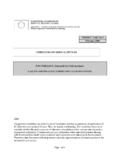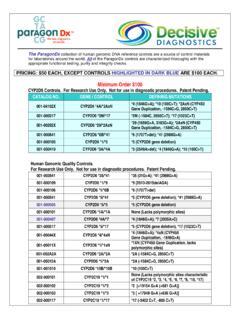Transcription of MEDDEV 2.14/1 revision 2 GUIDELINES ON MEDICAL DEVICES …
1 1 EUROPEAN COMMISSION DIRECTORATE GENERAL for HEALTH and CONSUMERS Consumer Affairs Health technology and Cosmetics MEDDEV revision 2 January 2012 GUIDELINES ON MEDICAL DEVICES IVD MEDICAL Device Borderline and Classification issues A GUIDE FOR MANUFACTURERS AND NOTIFIED BODIES Foreword The present Guideline is part of a set of GUIDELINES relating to questions of application of EC Directives on MEDICAL DEVICES . This guideline is not legally binding, since only the European Court of Justice can give an authoritative interpretation of Community law. It has been elaborated by an expert group including experts from Member States' Competent Authorities, the Commission services, as well as industry trade associations.
2 It is therefore intended that the document will provide useful guidance which should assist common positions to be taken throughout the European Union. Due to the participation of the aforementioned interested parties and of experts from Competent Authorities, it is anticipated that these GUIDELINES will be followed within the Member States and, therefore, ensure the uniform application of relevant Directive provisions. The present guideline provides non-exhaustive lists of examples of IVD MEDICAL DEVICES , accessories to IVD MEDICAL DEVICES and MEDICAL DEVICES .
3 Further detailed examples may be found in the Manual on Borderline and Classification in the Community Regulatory framework for MEDICAL DEVICES , published on the European Commission website1. Note: This document is a revision of an earlier document published in January 2004 as MEDDEV rev 1. 1 2 IN VITRO DIAGNOSTIC MEDICAL DEVICES : BORDERLINE ISSUES CONTENT Introduction Part A Qualification 1. General principles of qualification Definition of an IVD MEDICAL device Accessories Specimen receptacles and products used for the collection of Specimen receptacles Products used to obtain specimens Products for general laboratory use Products for research use only IVD kits Control Materials 2.
4 Specific cases on qualification Microbiological culture media Stains DEVICES with an invasive body contact for IVD purposes DEVICES where no specimen is involved DEVICES involved in biological or chemical warfare DEVICES to be used in law enforcement Relation with the Biocides Directive 98/8/EC Part B Classification 1. General principles on Classification 3 Interpretation of annex II, list A Interpretation of marker of infection wording Clarification of rare blood groups and subgroups Interpretation of annex II, list B Classification of Chlamydia detection IVD MEDICAL DEVICES Classification of in vitro diagnostic kits measuring parameters which can be used for evaluating the risk of trisomy 21 4 IN VITRO DIAGNOSTIC MEDICAL DEVICES : BORDERLINE ISSUES 1.
5 Introduction The demarcation between the IVD MEDICAL Device Directive 98/79/EC (IVDD), on the one hand, and other sectoral legislation, on the other hand, in particular the MEDICAL Device Directive 93/42/EC (MDD), is crucial for the proper implementation of these Directives and the correct interpretation and enforcement of national laws. In particular, the qualification of a product as an IVD or as a MEDICAL device will have an impact on: - the essential requirements and the conformity assessment procedures to be followed, - the appropriate technical specifications giving presumption of conformity (common technical specifications and harmonised standards), - the selection of a competent designated notified body to conduct the conformity assessment procedure.
6 The demarcation between the IVDD and the MDD is of fundamental importance because the MDD foresees in its article 1 that this Directive shall not apply to IVD MEDICAL DEVICES . Therefore, it was recognised that the subject needs to be further explained and illustrated by practical guidance. Part A - Qualification 1. General principles of qualification In deciding on whether a product falls within the scope of the IVD Directive, the primary consideration are the definitions set up in article 1 (2) of Directive 98/79/EC. Definition of an IVD Article 1(2) (b) of the IVDD defines an IVD as: in vitro diagnostic MEDICAL device means any MEDICAL device which is a reagent, reagent product, calibrator, control material, kit, instrument, apparatus, equipment, or system, whether used alone or in combination, intended by the manufacturer to be used in vitro for the examination of specimens, including blood and tissue donations, derived from the human body, solely or principally for the purpose of providing information.
7 Concerning a physiological or pathological state, or 5 concerning a congenital abnormality, or to determine the safety and compatibility with potential recipients, or to monitor therapeutic measures. The essential characteristics of an IVD are that: 1. The principal intended purpose of an IVD is to provide information on one or more of the following MEDICAL purposes: * information concerning a physiological state menopause assay, ovulation assay, pregnancy test or * information concerning a pathological state HIV assay * information concerning a congenital abnormality evaluation of the risk of trisomy 21 * to determine the safety and compatibility with potential recipients determination of blood groups of the ABO system * to monitor therapeutic measures digitoxin assay Note that tests for detecting drugs abuse/alcohol, intended to be used in law enforcement are not IVDs (see ) 2.
8 The IVD may provide this information either alone or in combination with other DEVICES or products 3. The IVD is used in vitro for the examination of a specimen derived from the human body and where such specimen is never reintroduced into the body. Note that if no specimen is involved, or if the examination takes place in or on the human body (in vivo), the DEVICES intended to be used for this examination are not IVDs. (see and ) Examples: - a pulse oxymeter emitting light through the fingertip and absorbing infrared light, to measure the oxy/deoxyhemoglobin ratio is not an IVD, - a continuous blood glucose monitoring system where the analytical function is carried out at the same time as the continuous specimen collection is not an IVD.
9 4. The IVD is used in vitro for the examination of a specimen derived from the human body. Note that DEVICES for detection of pathological agents in the environment are not IVDs. 6 From the definition it follows that in order to be qualified as an IVD the product must first fulfil the definition of a MEDICAL device2 and therefore must be intended by its manufacturer to be used for a MEDICAL purpose3. According to Article (h) of the IVDD, the intended purpose means the use for which the device is intended according to the data supplied by the manufacturer on the labelling, in the instructions for use and/or in promotional materials.
10 There may be cases where claims of a MEDICAL nature are made for certain products where those claims cannot be substantiated by technical, clinical and scientific data. If there is insufficient clinical, technical and scientific data to support the claims made, the product does not meet the requirements of the MDD and therefore shall not be CE marked as a MEDICAL device or an IVD. Products cannot be brought into the scope of the IVDD, merely by mentioning for in vitro diagnostic use . On the other hand, a product might have several intended uses. If one of these intended uses is the in vitro examination of human specimens and if a MEDICAL purpose can be established based on sufficient and broadly agreed scientific, diagnostic and clinical evidence, then the product must comply with the requirements of the IVDD before the manufacturer can place it on the market.











